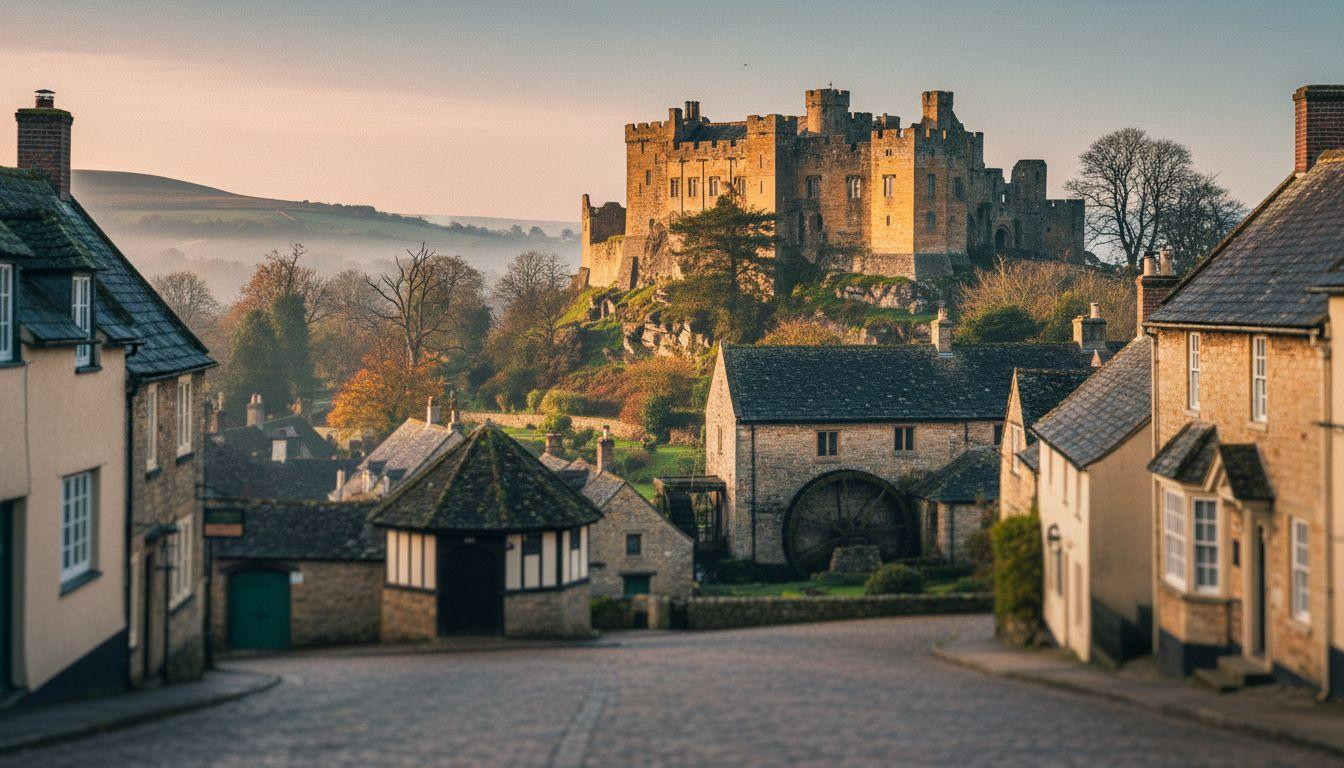Dawn breaks over Somerset at 6:47 AM, touching golden sandstone walls with soft light. Steam rises from teacups in 860 homes while an 11th-century castle stands silent above medieval streets. Forty minutes from Bristol Airport’s crowds, Dunster guards 1,000 years of history on Exmoor’s edge. The Luttrell family stewarded this fortress for 600 years before the National Trust opened terraced gardens where palms thrive impossibly far north. While Windsor Castle herds 1.6 million annual visitors through timed entry, Dunster’s 200,000 guests walk alone through subtropical blooms and Norman stone.
Where Somerset sandstone meets Exmoor wilderness
Dunster perches at civilization’s edge, where Somerset’s gentle valleys meet Exmoor National Park’s moorland expanse. The village sits 1.5 miles from Minehead’s coast, yet its wooded tor rises 490 feet above sea level. Golden honey-colored sandstone defines every surface: castle walls, the 1420 gatehouse, village cottages, the medieval Yarn Market where wool traders once gathered.
The River Avill flows through the valley, powering an 18th-century watermill that still grinds local grain. Arriving via the heritage West Somerset Railway from Bishops Lydeard, steam locomotives deliver visitors into landscapes unchanged since Victorian times. The A39 passes nearby, but Dunster feels profoundly removed from modern England’s rush.
The castle that never fell
Dunster Castle’s 1,000-year story defies England’s typical siege-and-ruin narrative. Built shortly after 1066 as Norman motte-and-bailey fortress, it evolved continuously rather than catastrophically. The Luttrell family acquired it in 1376 and maintained stewardship for 600 years until transferring ownership to the National Trust in 1976.
From medieval fortress to Victorian elegance
Architect Anthony Salvin remodeled the castle between 1868-1872, transforming defensive stone into Victorian country house. The castle’s silhouette reveals its evolution: Norman foundations, the 1420 medieval gatehouse, then 19th-century additions including ornate interiors and family tapestries. Unlike Windsor’s fortified grandeur, Dunster became home where medieval and Victorian sensibilities coexist naturally.
Subtropical gardens at 51 degrees north
The terraced gardens stun visitors expecting typical English roses. Gulf Stream microclimates and south-facing slopes support palms, Mediterranean cypresses, subtropical blooms at this northern latitude. Woodland walks wind through exotic plantings while panoramic viewpoints capture Bristol Channel vistas. November brings autumn color against evergreen palms, mist rising from valleys below.
Living history beyond castle walls
Dunster village extends the castle’s preservation philosophy into daily life. Cobblestone High Street leads past the octagonal Yarn Market built in 1609, where medieval wool merchants traded under timber beams. The working watermill on River Avill demonstrates 18th-century grain grinding while visitors watch the 30-foot wheel turn and smell fresh flour.
Walking Exmoor’s doorstep
Footpaths from Dunster climb directly into Exmoor National Park territory. Grabbist Hill offers 360-degree views across moor, coast, and valley after a 2.5-mile round trip. Bat’s Castle Iron Age hillfort sits 1.2 miles north with double ramparts enclosing 5 acres. November hiking means solitude and copper-colored bracken under sharp sea air.
Somerset’s authentic flavors
Village establishments serve locally sourced fare without tourist markup. The Luttrell Arms, a 15th-century inn, offers cream teas in medieval surroundings for $8-12. Local pubs feature Exmoor venison, Somerset lamb, cheddar from nearby Cheddar Gorge, and traditional apple cider from heritage orchards. Main courses range $15-25, significantly less than Bath’s tourist restaurants 40 miles southeast.
England’s quiet alternative to crowded heritage
Bath draws 5.8 million annual visitors while Stonehenge welcomes 1.6 million yearly. Dunster’s 200,000 guests seem substantial until you walk castle grounds at 8 AM in November, alone except for birdsong and rising mist. The village offers what commercialized heritage sites sacrifice: silence, intimacy, unhurried pace.
You touch 11th-century stone without barriers, wander Victorian gardens without crowds, watch the watermill’s wheel turn without audio commentary. The West Somerset Railway’s steam trains add authentic nostalgia, not theme-park artifice. This represents heritage as lived experience rather than curated museum display.
Your questions about Dunster answered
How do I reach Dunster without a car?
Train to Taunton from London Paddington takes 2 hours, costing $55-100 for advance fares. Then board the West Somerset Railway heritage steam service to Minehead, followed by a 1.5-mile taxi ride or scenic walk to Dunster village center. Bristol Airport sits 75 minutes away by taxi, costing $80-110.
What makes Dunster different from Windsor or Edinburgh castles?
Scale and intimate access define the difference. No security queues, no timed entry, no crowd control barriers. Visitors wander terraced gardens alone, explore Victorian rooms at personal pace, touch medieval stonework directly. National Trust admission of $20 adults and $10 children grants hours of unhurried exploration across 20 acres of grounds.
When should Americans plan their visit?
May through September offers garden blooms and mild temperatures ranging 55-70°F. November through February provides atmospheric mist, autumn colors, empty walking paths, and special castle events including Christmas decorations and exclusive attic tours. Avoid July-August peak season when crowds triple.
Evening light turns Somerset sandstone amber-gold as Bristol Channel catches final sun. The castle stands silent above empty village streets while mist rises from River Avill. Six centuries of Luttrell stewardship, 1,000 years of continuous habitation. Dunster endures not as frozen museum, but as England’s medieval heart still beating.
